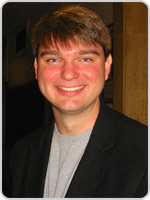- Details
-
Published: Tuesday, May 17 2011 16:22
Ian Appelbaum was awarded the 2011 Outstanding Young Scientist award by the Maryland Science Center. He is the first recipient of the newly endowed award.
Read More
- Details
-
Published: Monday, May 09 2011 11:32

Carter Hall was one of 65 scientists from across the nation selected to receive a prestigious U.S. Department of Energy Early Career Award. The award was designed to bolster the nation's scientific workforce by providing support to exceptional researchers during the crucial early career years when many scientists do their most formative work.
Professor Hall's project was titled, "Search for Weakly Interacting Dark Matter Liquid Xenon." He is a player in the LUX collaboration, one of the premier experiments searching for evidence of Dark Matter.
- Details
-
Published: Thursday, May 05 2011 11:51
A podcast of Jim Gates' talk at the 2008 World Science Festival, Go Tell it on the Mountain, is available for free on The Moth.
- Details
-
Published: Thursday, April 14 2011 09:14
University of Maryland researchers have discovered a way to control magnetic properties of graphene that could lead to powerful new applications in magnetic storage and magnetic random access memory.
The finding by a team of Maryland researchers, led by Physics Professor Michael S. Fuhrer of the UMD Center for Nanophysics and Advanced Materials is the latest of many amazing properties discovered for graphene.
Read More
- Details
-
Published: Friday, April 08 2011 09:37
The article Superconductivity at 23 K in Pt doped BaFe2As2 single crystals, by researchers at the UMD Physics, was selected as part of IoP Science's Highlights of 2010. Originally published in Journal of Physics: Condensed Matter, the article was selected for receiving some of the highest praise from referees and for its high number of downloads.
This research is supported by Maryland's AFOSR-MURI grant, involving Richard Green, Johnpierre Paglione and Ichiro Takeuchi.
Vivid graphics and exciting mechanics create thrilling fun for myth casino lovers at
Zeus vs Hades.

